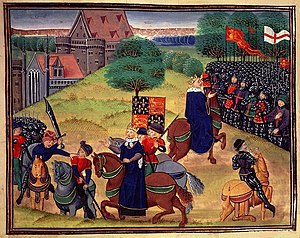 |
| Images like this were very common in the Arab Spring of 2011 |
One of the most interesting things about history is realising that things weren't the same in the past. Now, this might seem like an obvious thing to say but to understand what life was like before the fourteenth century, you must appreciate that there were fewer ways of getting your feelings heard.
In fact, despite our image that Medieval peasants probably did have a great deal to complain about, revolts were very rare. Civil wars between competing members of the royal family were quite regular but the idea of changing things through popular uprising wasn't really part of the medieval mindset. The infrequency was also due to widespread castles full of soldiers ready to knock the stuffing out of you if you so much as suggested that going to war with France (again) wasn't really a good idea.
 Given these conditions, the fact that ordinary people rose up against their king over the issues which troubled them is groundbreaking. There were a whole host of reasons for this but some of them have a vague similarity with protests today. Foreign wars, taxes, land ownership and working conditions were some of the main reasons behind a wave of anger which swept through parts of England in 1381. Crucially, the Black Death had hit nearly 35 years before and this had stirred things up more than ever before, adding extra fuel to the flames. With fewer people around to do work, workers could demand better conditions and many had acquired land for the first time which they certainly did not want to lose. Despite the psyche against uprising and the horrific punishments for such action, thousands of ordinary people marched on London led by Wat Tyler, John Ball and Jack Straw.
Given these conditions, the fact that ordinary people rose up against their king over the issues which troubled them is groundbreaking. There were a whole host of reasons for this but some of them have a vague similarity with protests today. Foreign wars, taxes, land ownership and working conditions were some of the main reasons behind a wave of anger which swept through parts of England in 1381. Crucially, the Black Death had hit nearly 35 years before and this had stirred things up more than ever before, adding extra fuel to the flames. With fewer people around to do work, workers could demand better conditions and many had acquired land for the first time which they certainly did not want to lose. Despite the psyche against uprising and the horrific punishments for such action, thousands of ordinary people marched on London led by Wat Tyler, John Ball and Jack Straw.
As they marched, things got more out of control. They burned local tax offices, looted parts of London (sound familiar?) and even killed the Archbishop of Canterbury. They even occupied London (not just the green outside St. Paul's) and real anarchy seemed to reign. The revolt ended in two meetings at Mile End and Smithfield outside the city walls. At the first, King Richard II, who was only 14, heard the demands of the Peasants and agreed to them all. What happened at Smithfield is unclear (a future blog entry could follow) but the Lord Mayor killed Wat Tyler and the revolt largely dissipated from there. The King went back on his promises and most of the leaders were executed.
On one level the revolt was a disaster: it failed in all its objectives. However, conditions did slowly get better for ordinary people. The upper classes had received a huge shock and a realisation took place about their potential lack of control. Interestingly despite their irregularity before, revolts seemed to happen with more frequency across the whole of Europe from the fourteenth century onward. Life was never easy at the bottom of the the medieval world but something about this time period seems to have changed things. The way in which ordinary people felt that they could change things shifted in this period in a way that isn't easy to explain.
So, when you watch news of protests, the Arab Spring or even the reasons behind the 2011 London Riots, perhaps that might help you to picture life in ordinary towns and villages in June 1381.
On one level the revolt was a disaster: it failed in all its objectives. However, conditions did slowly get better for ordinary people. The upper classes had received a huge shock and a realisation took place about their potential lack of control. Interestingly despite their irregularity before, revolts seemed to happen with more frequency across the whole of Europe from the fourteenth century onward. Life was never easy at the bottom of the the medieval world but something about this time period seems to have changed things. The way in which ordinary people felt that they could change things shifted in this period in a way that isn't easy to explain.
So, when you watch news of protests, the Arab Spring or even the reasons behind the 2011 London Riots, perhaps that might help you to picture life in ordinary towns and villages in June 1381.

